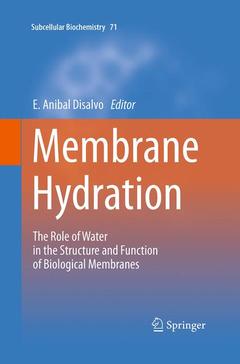Description
Membrane Hydration, Softcover reprint of the original 1st ed. 2015
The Role of Water in the Structure and Function of Biological Membranes
Subcellular Biochemistry Series, Vol. 71
Language: English
Subjects for Membrane Hydration:
Publication date: 08-2016
Support: Print on demand
Publication date: 10-2015
284 p. · 15.5x23.5 cm · Hardback
Description
/li>Contents
/li>Comment
/li>
This book is about the importance of water in determining the structure, stability and responsive behavior of biological membranes. Water confers to lipid membranes unique features in terms of surface and mechanical properties. The analysis of the hydration forces, plasticiser effects, controlled hydration, formation of microdomains of confined water suggests that water is an active constituent in a water-lipid system.
The chapters describe water organization at the lipid membrane?water interphase, the water penetration, the long range water structure in the presence of lipid membranes by means of X-ray and neutron scattering, general polarization, fluorescent probes, ATR-FTIR and near infrared spectroscopies, piezo electric methods, computer simulation and surface thermodynamics.
Permeation, percolation, osmotic stress, polarization, protrusion, sorption, hydrophobicity, density fluctuations are treated in detail in self-assembled bilayers. Studies in lipid monolayers show the correlation of surface pressure with water activity and its role in peptide and enzyme interactions. The book concludes with a discussion on anhydrobiosis and the effect of water replacement in microdomains and its consequence for cell function.
New definitions of lipid/water interphases consider water not only as a structural-making solvent but as a mediator in signalling metabolic activity, modulating protein insertion and enzymatic activity, triggering oscillatory reactions and functioning of membrane bound receptors. Since these effects occur at the molecular level, membrane hydration appears fundamental to understand the behavior of nano systems and confined environments mimicking biological systems.
These insights in structural, thermodynamical and mechanical water properties give a base for new paradigms in membrane structure and function for those interested in biophysics, physical chemistry, biology, bio and nano medicine, biochemistry,
biotechnology and nano sciences searching for biotechnological inputs in human health, food industry, plant growing and energy conversion.Preface
Acknowledgements
1. Membrane Hydration: A hint to a new model for biomembranes;E. Anibal Disalvo
2. Use of X-ray and neutron scattering methods with volume measurements to determine lipid bilayer structure and number of water molecules/lipid; Stephanie Tristram-Nagle
3. Water and Lipid Bilayers;Jonathan D. Nickels and John Katsaras
4. Hydration forces between lipid bilayers – a theoretical overview and a look on methods exploring dehydration; Helge Pfeiffer
5. Monitoring membrane hydration with 2-(dimethylamino)-6-acylnaphtalenes fluorescent probes;Luis A. Bagatolli
6.Long-Range Lipid-Water Interaction as Observed by ATR-FTIR Spectroscopy;Zoran Arsov
7. Hydration And Nanoconfined Water. Some Insights From Computer Simulations;L. M. Alarcón, J. A. Rodríguez Fris, M. A. Morini, M. B. Sierra, S. A. Accordino, J. M. Montes de Oca, V. I. Pedroni and G. A. Appignanesi
8.Aquaphotomics: near infrared spectroscopy and water states in biological systems;Roumiana Tsenkova, Zoltan Kovacs, Yosuke Kubota
9. Hydration in lipid monolayers: Correlation of water activity and surface pressure;E. Anibal Disalvo, Hollmann, A. and Martini, M.F.
10. Water at Biological Phase Boundaries: Its Role in Interfacial activation of enzymes and metabolic pathways; Srinivasan Damodaran
11. Anhydrobiosis: An Unsolved Problem With Applications in Human Welfare;John Crowe
Provides details in modern techniques in surface properties of lipid membranes
Correlates several aspects of membrane studies in relation to water properties that are scattered in the current literature
Gives an outstanding coverage of specific bibliography
Opens a new window to understand membrane phenomena in relation to biological functions




